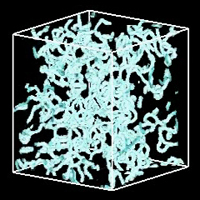Statistical mechanics of fluid turbulence based on the cross-independence closure hypothesis
Duration: 29 mins 34 secs
Share this media item:
Embed this media item:
Embed this media item:
About this item

| Description: |
Tatsumi, T (Kyoto)
Wednesday 01 October 2008, 16:30-17:00 |
|---|
| Created: | 2008-10-22 15:31 | ||
|---|---|---|---|
| Collection: | The Nature of High Reynolds Number Turbulence | ||
| Publisher: | Isaac Newton Institute | ||
| Copyright: | Tatsumi, T | ||
| Language: | eng (English) | ||
| Distribution: |
World
|
||
| Credits: |
|
||
| Explicit content: | No | ||
| Aspect Ratio: | 4:3 | ||
| Screencast: | No | ||
| Bumper: | /sms-ingest/static/new-4x3-bumper.dv | ||
| Trailer: | /sms-ingest/static/new-4x3-trailer.dv | ||
| Abstract: | Statistical theory of turbulence is presented, which deals with homogeneous isotropic turbulence and inhomogeneous turbulent flows, their large-scale structures and small-scale similarities on an equal footing, using the "cross-independence closure hypothesis" proposed by Tatsumi(2001) for closing the Lundgren-Monin equations(1967) for the multi-point velocity distributions. Homogeneous isotropic turbulence at large Reynolds numbers is shown to be governed by the closed set of the one- and two-point velocity distributions. The distributions are expressed as the universal inertial-normal distributions associated with their own energy-dissipation rates as only parameters. Only exception from this universality is the longitudinal velocity-difference distribution, which is given by the local non-normal distributions in the inertial and viscous subranges. These theoretical results are discussed in comparison with the existing experimental and numerical results. Inhomogeneous turbulent flows at large Reynolds numbers are shown to be governed by the closed set of equations for the mean velocity and the one- and two-point velocity distributions. These equations have eminent feature that the effect of the mean flow is limited to the lage-scale components of turbulence. This feature is expected to largely simplify the formalism of shear-flow turbulence just like the 'boundary layer' in laminar flows.
A seminar from the Inertial-Range Dynamics and Mixing conference in association with the Newton Institute programme: The Nature of High Reynolds Number Turbulence www.newton.ac.uk/programmes/HRT/seminars/ |
|---|---|
Available Formats
| Format | Quality | Bitrate | Size | |||
|---|---|---|---|---|---|---|
| MPEG-4 Video | 480x360 | 1.83 Mbits/sec | 407.02 MB | View | Download | |
| WebM | 450x360 | 609.46 kbits/sec | 131.31 MB | View | Download | |
| Flash Video | 480x360 | 801.62 kbits/sec | 174.18 MB | View | Download | |
| iPod Video | 480x360 | 502.8 kbits/sec | 109.25 MB | View | Download | |
| QuickTime | 384x288 | 843.73 kbits/sec | 183.33 MB | View | Download | |
| MP3 | 44100 Hz | 125.02 kbits/sec | 26.80 MB | Listen | Download | |
| Windows Media Video | 475.01 kbits/sec | 103.21 MB | View | Download | ||
| Auto * | (Allows browser to choose a format it supports) | |||||

